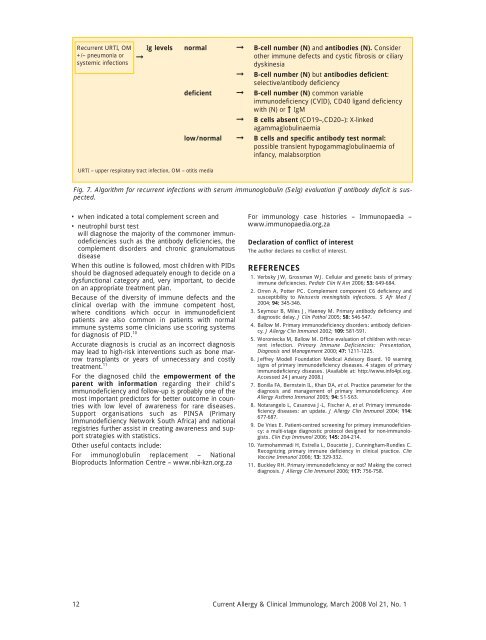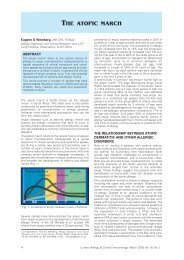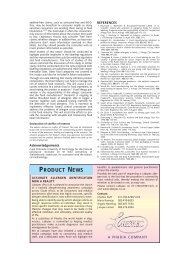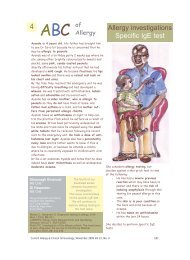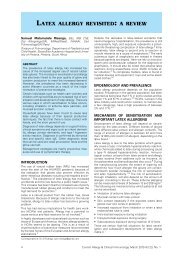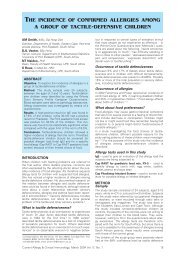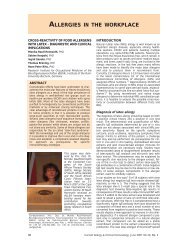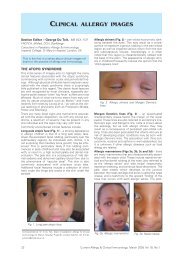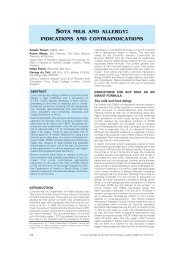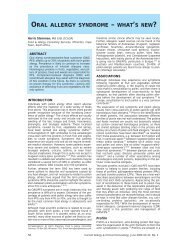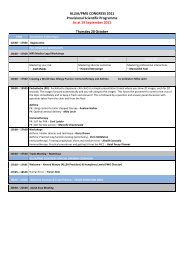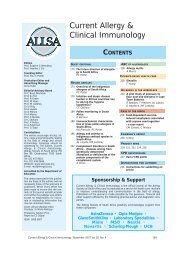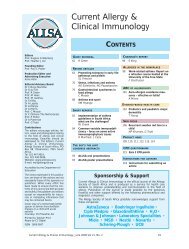Current Allergy and Clinical Immunology - March 2008
Current Allergy and Clinical Immunology - March 2008
Current Allergy and Clinical Immunology - March 2008
Create successful ePaper yourself
Turn your PDF publications into a flip-book with our unique Google optimized e-Paper software.
Recurrent URTI, OM+/– pneumonia orsystemic infections➞Ig levels normal ➞ B-cell number (N) <strong>and</strong> antibodies (N). Considerother immune defects <strong>and</strong> cystic fibrosis or ciliarydyskinesia➞ B-cell number (N) but antibodies deficient:selective/antibody deficiencydeficient ➞ B-cell number (N) common variableimmunodeficiency (CVID), CD40 lig<strong>and</strong> deficiencywith (N) or IgM➞ B cells absent (CD19–,CD20–): X-linkedagammaglobulinaemialow/normal ➞ B cells <strong>and</strong> specific antibody test normal:possible transient hypogammaglobulinaemia ofinfancy, malabsorption➞URTI – upper respiratory tract infection, OM – otitis mediaFig. 7. Algorithm for recurrent infections with serum immunoglobulin (SeIg) evaluation if antibody deficit is suspected.• when indicated a total complement screen <strong>and</strong>• neutrophil burst testwill diagnose the majority of the commoner immunodeficienciessuch as the antibody deficiencies, thecomplement disorders <strong>and</strong> chronic granulomatousdiseaseWhen this outline is followed, most children with PIDsshould be diagnosed adequately enough to decide on adysfunctional category <strong>and</strong>, very important, to decideon an appropriate treatment plan.Because of the diversity of immune defects <strong>and</strong> theclinical overlap with the immune competent host,where conditions which occur in immunodeficientpatients are also common in patients with normalimmune systems some clinicians use scoring systemsfor diagnosis of PID. 10Accurate diagnosis is crucial as an incorrect diagnosismay lead to high-risk interventions such as bone marrowtransplants or years of unnecessary <strong>and</strong> costlytreatment. 11For the diagnosed child the empowerment of theparent with information regarding their child'simmunodeficiency <strong>and</strong> follow-up is probably one of themost important predictors for better outcome in countrieswith low level of awareness for rare diseases.Support organisations such as PINSA (PrimaryImmunodeficiency Network South Africa) <strong>and</strong> nationalregistries further assist in creating awareness <strong>and</strong> supportstrategies with statistics.Other useful contacts include:For immunoglobulin replacement – NationalBioproducts Information Centre – www.nbi-kzn.org.zaFor immunology case histories – Immunopaedia –www.immunopaedia.org.zaDeclaration of conflict of interestThe author declares no conflict of interest.REFERENCES1. Verbsky JW, Grossman WJ. Cellular <strong>and</strong> genetic basis of primaryimmune deficiencies. Pediatr Clin N Am 2006; 53: 649-684.2. Orren A, Potter PC. Complement component C6 deficiency <strong>and</strong>susceptibility to Neisseria meningitidis infections. S Afr Med J2004; 94: 345-346.3. Seymour B, Miles J, Haeney M. Primary antibody deficiency <strong>and</strong>diagnostic delay. J Clin Pathol 2005; 58: 546-547.4. Ballow M. Primary immunodeficiency disorders: antibody deficiency.J <strong>Allergy</strong> Clin Immunol 2002; 109: 581-591.5. Woroniecka M, Ballow M. Office evaluation of children with recurrentinfection. Primary Immune Deficiencies: Presentation,Diagnosis <strong>and</strong> Management 2000; 47: 1211-1225.6. Jeffrey Modell Foundation Medical Advisory Board. 10 warningsigns of primary immunodeficiency diseases. 4 stages of primaryimmunodeficiency diseases. (Available at: http://www.info4pi.org.Accessed 24 January <strong>2008</strong>.)7. Bonilla FA, Bernstein IL, Khan DA, et al. Practice parameter for thediagnosis <strong>and</strong> management of primary immunodeficiency. Ann<strong>Allergy</strong> Asthma Immunol 2005; 94: S1-S63.8. Notarangelo L, Casanova J-L, Fischer A, et al. Primary immunodeficiencydiseases: an update. J <strong>Allergy</strong> Clin Immunol 2004; 114:677-687.9. De Vries E. Patient-centred screening for primary immunodeficiency:a multi-stage diagnostic protocol designed for non-immunologists.Clin Exp Immunol 2006; 145: 204-214.10. Yarmohammadi H, Estrella L, Doucette J, Cunningham-Rundles C.Recognizing primary immune deficiency in clinical practice. ClinVaccine Immunol 2006; 13: 329-332.11. Buckley RH. Primary immunodeficiency or not? Making the correctdiagnosis. J <strong>Allergy</strong> Clin Immunol 2006; 117: 756-758.12 <strong>Current</strong> <strong>Allergy</strong> & <strong>Clinical</strong> <strong>Immunology</strong>, <strong>March</strong> <strong>2008</strong> Vol 21, No. 1


